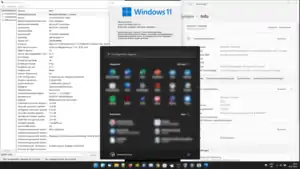Windows 11
Windows 11 is the newest and current operating system from Microsoft. It is the successor of Windows 10 and was announced on June 24, 2021.[1] It was released on October 5, 2021 and is a free upgrade for Windows 10 or Windows 8.1 users.[2] However many users cannot upgrade to Windows 11 or run Windows 11 because it has many system requirements. [3] [4]It's mainstream support will end on January 12, 2027 and extended support will end on January 13, 2032.
| A version of the Windows NT-based operating system | |
 Windows 11 logo and desktop | |
| Developer | Microsoft |
|---|---|
| OS family | Microsoft Windows |
| Released to manufacturing | June 24, 2021 |
| General availability | October 5, 2021 |
| Preceded by | Windows 10 (2015) |
| Official website | www |
| Support status | |
| Support started on October 5, 2021 Mainstream support: Until January 12, 2027; 5 years' time Extended support: Until January 13, 2032; 10 years' time | |
Related pages
Other websites
References
- Haselton, Jordan Novet,Kif Leswing,Todd (2021-06-24). "Microsoft just unveiled Windows 11: Here's everything it announced". CNBC. Retrieved 2021-06-28.
- "How check whether your laptop, desktop is compatible with Windows 11 in few simple steps". Gadgets Now. Retrieved 2021-06-28.
- Mearian, Lucas (2022-04-13). "More than half of PCs can't upgrade to Windows 11 — report". Computerworld. Retrieved 2022-05-12.
- "Windows 11 System Requirements". support.microsoft.com. Retrieved 2022-05-12.
- softwarelozi (2021-10-21). "Upgrade to Windows 11: Is it Worth It?". Softwarelozi. Retrieved 2021-11-11.
This article is issued from Wikipedia. The text is licensed under Creative Commons - Attribution - Sharealike. Additional terms may apply for the media files.